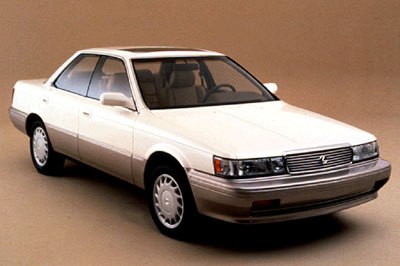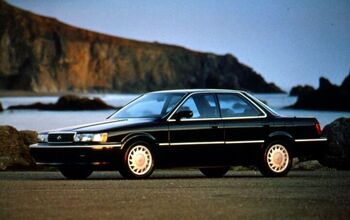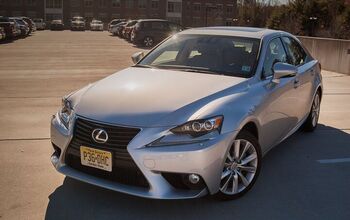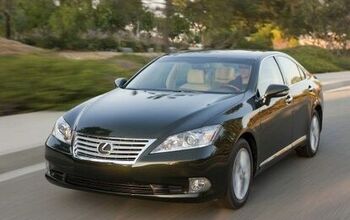1.2K Views
Capsule Review: 1990 Lexus ES250

by
Jack Baruth
(IC: employee)
Published: June 4th, 2010
Share
As a nameplate, Lexus is now old enough to consume alcohol in all fifty states. Make no mistake, though: the brand Lexus has become is not the brand it was perhaps originally intended to be. Toyota and Nissan each launched with a (mostly) clean-sheet big V8 sedan and a warmed-over home-market showroom filler. For Nissan, the lineup was a short-wheelbase version of the all-new “President”, badged Q45, and a long-in-the-tooth Leopard coupe, yclept M30. Toyota introduced its “F1” global flagship as the Lexus LS400. To keep the new LS from being lonely in the showrooms, a quick nose job was done on a JDM faux-hardtop midsizer, and the ES250 was born.Perhaps the Japanese thought they could win the “D-class” battle against BMW and Mercedes-Benz as easily as they’d destroyed the British motorcycle industry or humiliated the American attempts to build subcompact cars. It didn’t quite work out that way. The Q45 badge moved to the rather dismal Nissan Cima before completely fading away. The M30 was a sales catastrophe, to put it mildly. While the current LS460 does about the same annual volume in the United States as the Mercedes-Benz S550, it does so with a base price that is almost $23,000 below that of the Benz.It was the humblest of the original four offerings from Lexus and Infiniti that would go on to conquer, if not the world, then at least the continent of North America. Today, Lexus is one of the top-volume luxury brands in the market. Its killer Camry-derived duo of %20http://www.thetruthaboutcars.com/capsule-review-2010-lexus-es350/" rel="nofollow noopener" target="_blank">%20http://www.thetruthaboutcars.com/capsule-review-2010-lexus-es350/">ES 350 and RX350 perennially occupy the top of their segments’ sales charts, generating over 100,000 sales per year. Lexus is one of the most famous success stories in the industry, but it began with a straight badge-engineering job of a nearly obsolete car.
For many years, Japanese home-market buyers equated “the hardtop look” with prestige and luxury. As a result, nearly every major Japanese sedan sold in the Eighties and Nineties was either a frameless-window car (as was the case with the first-generation Infiniti M45, sold in Japan as the Nissan Cedric) or was available in a more expensive, frameless-window variant (as with the Honda Accord Inspire and Toyota Corona EXIV). In Toyota’s case, the Camry was “upgraded” to become the Toyota Vista, as seen above. The advantages of using the Vista as the second Lexus were obvious. It could easily be made to comply with US regulations and it would be immediately familiar to Toyota owners looking to trade up.I’m a little embarrassed to admit this, but my family has some history with Lexus ownership in general and ES250 ownership in particular. In the winter of 1989 my father had his Jaguar XJ6 towed out of his garage stall to the dealership for the fourth time in about as many months. I advised that he try a Lexus as a temporary change in pace. I meant that he should buy an LS400, but upon his trip to the dealer he decided thata) both of the Lexus vehicles were ugly pieces of crap;b) in which case, the cheaper one would suffice.And thus the old man acquired a two-tone-blue ES250. He’d never even so much as sat in a Camry, but I had, and I was shocked to see the lack of differentiation between the two. The steering wheel was different, the radio stack was different, and there were better seats in the car. That was it. Other than that, we were looking at a $23,500 variant of a $17,000 Camry V6.
The motor was surprisingly reluctant to rev, given that it was a 2.5L V6. It was also gutless at all revs; I got the somewhat mistaken impression that it was about as quick as my 302-powered Mercury Marquis coupe. On the freeway, it had less mechanical noise than a Camry but a fair bit more wind noise. The steering was loaded with syrup and the brake pedal sank halfway to the floor before providing any effective retardation. On the positive side, the stereo was very good and the interior was clearly screwed together with fastidious attention.After a few years, the ES became Dad’s “Florida car”. The leather seats cracked, the dash faded to a whiter shade of blue, and the electronics started to quit. In 1994, with 122,000 mostly freeway miles on the odometer, the block cracked and Dad effectively gave the car away. I used to joke that he’d managed to transfer the reliability of his Jags and Bimmers to a Toyota.The LS400 outsold the ES250 by quite a bit in the two years they were sold together. Toyota got the hint; the Vista became the vastly improved Windom and placing an “L” badge on said Windom yielded the ES300. Customers loved the result and the ES was placed on the road to complete domination. Over the next three generations, the ES/Windom continued to distance itself from the Camry, but the template had been set: everybody from Acura to Lincoln ended up copying Lexus and selling chrome-nose family sedans as entry-level luxury cars. In the case of the Lincoln Zephyr/MKZ, there was a double helping of irony since the Lincoln Versailles had been an unsuccessful riff on the Ford Granada fifteen years before the ES250’s introduction.Speaking of irony, it’s worth nothing that in 2006, Toyota took the final step and discontinued the Windom nameplate, replacing it with… Lexus ES. It’s been the most successful example of badge-engineering since the half-million-selling ’76 Cutlass, and perhaps the only one where the rebadge turned around and swallowed the original nameplate. The Little Camry That Couldn’t eventually became the Big Lexus That Could.

Jack Baruth
More by Jack Baruth
Published June 4th, 2010 2:27 PM
Latest Car Reviews
Read moreLatest Product Reviews
Read moreRecent Comments
- Jalop1991 Way to bury the lead. "Toyota to offer two EVs in the states"!
- Jalop1991 I'm sorry, Dave. I'm afraid I can't do that.
- Jalop1991 We need a game of track/lease/used/new.
- Ravenuer This....by far, my most favorite Cadillac, ever.
- Jkross22 Their bet to just buy an existing platform from GM rather than build it from the ground up seems like a smart move. Building an infrastructure for EVs at this point doesn't seem like a wise choice. Perhaps they'll slow walk the development hoping that the tides change over the next 5 years. They'll probably need a longer time horizon than that.




































Comments
Join the conversation
When I was in high school my father gave me a 1989 Toyota Camry V6 LE. It was a great little car but I always wished it was the Lexus ES250 because it was the same car but more luxurious and much more unusual.
I'm thrilled to see this article on the long forgotten ES250. I was a big fan of this car when it came out. Around that time of 1990 I was enamored with Japanese cars, they really seemed so superior and every new release was such an advance. Of course Lexus was the latest triumph and the LS 400 was the "best car in the world." Unfortunately, I knew the big Lexus was way beyond my family's reach, so I latched onto the next best thing, the ES250. My dad was looking for a replacement for our family's Maxima, and I lobbied hard for the ES250. When I went to the Lexus dealership, I was blown away by the experience. I had already been to a lot of car dealerships at that age (13) and Lexus was nothing like any I had been to. It was more like visiting a fancy bank, with granite floors, leather couches and a classy, subdued atmosphere. We actually had a female (very rare to this day) sales agent who had an educated, professional demeanor unlike any car salesman I had seen. I think I still have the thick sales booklet for the ES250 from that visit. At any rate, my dad didn't buy the ES250 and instead picked up a lightly used '88 Acura Legend. I was alright with that pick and I later got a lot of enjoyment driving that car. One last thought - the ES250 and Acura Legend to some extent competed with the entry-level German cars like the 3-series and Mercedes 190E. Despite all the auto rags picking the new Japanese upstarts over the staid 190E (see the C&D comparo from I think '92), I have to say that today I still see old Mercedes all over the road and those original Lexi and Acuras seem to have been driven into the ground.